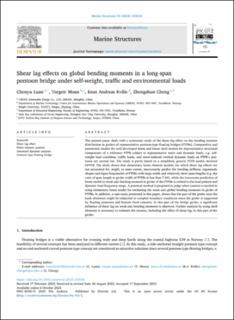| dc.contributor.author | Luan, Chenyu | |
| dc.contributor.author | Moan, Torgeir | |
| dc.contributor.author | Kvåle, Knut Andreas Kirkestuen | |
| dc.contributor.author | Cheng, Zhengshun | |
| dc.date.accessioned | 2024-01-09T12:30:31Z | |
| dc.date.available | 2024-01-09T12:30:31Z | |
| dc.date.created | 2023-11-28T12:27:44Z | |
| dc.date.issued | 2023 | |
| dc.identifier.issn | 0951-8339 | |
| dc.identifier.uri | https://hdl.handle.net/11250/3110617 | |
| dc.description.abstract | The present paper deals with a systematic study of the shear lag effect on the bending moment distribution in girders of representative pontoon-type floating bridges (PTFBs). Comparative and parametric studies for well-developed beam and linear shell models for representative structural components of a reference PTFB subject to representative static and dynamic loads, e.g. self-weight load condition, traffic loads, and wave-induced vertical dynamic loads on PTFB's pontoons are carried out. The study is partly based on a simplified, generic PTFB model, denoted GPTFB. The study shows that elementary beam element models, for which shear lag effects are not accounted for, might, to some extent, inaccurately predict the bending stiffness, eigenmode shapes and eigen frequencies of PTFBs with large width and relatively short span lengths (e.g. the ratio of span length to girder width of PTFBs is less than 7.24), while the inaccurate prediction of beam model in weak axis bending moment in girder of the PTFBs is related to the load pattern and dynamic load frequency range. A practical method is proposed to judge when caution is needed in using elementary beam model for estimating the weak axis global bending moments in girder of PTFBs. In addition, a case study presented in this paper, shows that the part of the girder near the bank abutment might be subjected to complex boundary conditions since the girder is supported by floating pontoons and bottom fixed columns. In this part of the bridge girder, a significant influence of shear lag on weak axis bending moments is observed. Further analysis by using shell elements is necessary to estimate the stresses, including the effect of shear lag, in this part of the girder. | en_US |
| dc.language.iso | eng | en_US |
| dc.publisher | Elsevier | en_US |
| dc.rights | Navngivelse 4.0 Internasjonal | * |
| dc.rights.uri | http://creativecommons.org/licenses/by/4.0/deed.no | * |
| dc.title | Shear lag effects on global bending moments in a long-span pontoon bridge under self-weight, traffic and environmental loads | en_US |
| dc.title.alternative | Shear lag effects on global bending moments in a long-span pontoon bridge under self-weight, traffic and environmental loads | en_US |
| dc.type | Peer reviewed | en_US |
| dc.type | Journal article | en_US |
| dc.description.version | publishedVersion | en_US |
| dc.source.journal | Marine Structures | en_US |
| dc.identifier.doi | 10.1016/j.marstruc.2023.103518 | |
| dc.identifier.cristin | 2203719 | |
| cristin.ispublished | true | |
| cristin.fulltext | original | |
| cristin.qualitycode | 2 | |

